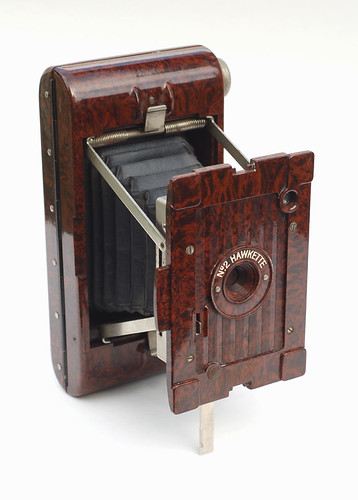Bakelite

|
| Kodak No. 2 Hawkette image by John Kratz (Image rights) |
Bakelite is a thermosetting resin; a polymer formed by the reaction of phenol and formaldehyde. It was used in camera making from the 1930s to the 1960s. Before it has set, the resin can be cast in a mould; once set, it is hard enough to be drilled, and does not soften again or deform when heated. It is non-flammable and electrically insulating. Because of these useful properties, many products were made from Bakelite - for example radios, electrical fittings and kitchen utensils. Bakelite's ability to be moulded into complex flowing shapes allowed manufacturers to give products art-deco or streamline moderne style. Bakelite is limited in color palette and is mostly seen in darker brown, maroon, or black. In some examples it may have a marbled appearance.
The name "Bakelite" is derived from that of its inventor, Belgian chemist Leo Baekeland, who formed the General Bakelite Company to exploit it. Baekeland also invented Velox photographic paper.
See Category: Bakelite for a list of Bakelite cameras.
Links
In English:
- Bakelite story at Marriott's World (archived)
- Bakelite and Plastic Museum (archived)
- Bakelite cameras at Reijo Lauro's Camera Site
- Wikipedia article on Bakelite material
- Amsterdam Bakelite Collection
In Dutch:
- Bakeliet, a website about bakelite, with pages about the bakelite cameras (follow the "Vervolg / Next" links to see more cameras)